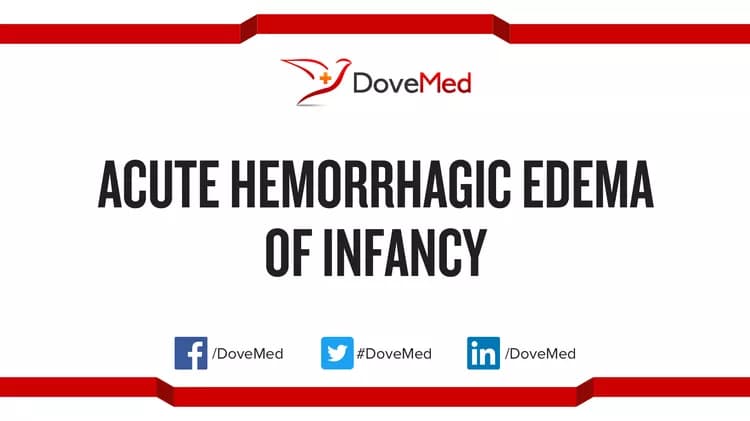What are the Other Names for this Condition? (Also known as/Synonyms)
- Acute Haemorrhagic Oedema of Infancy
- Finkelstein Disease
What is Acute Hemorrhagic Edema of Infancy? (Definition/Background Information)
- Acute Hemorrhagic Edema of Infancy is a rare vasculitis skin condition. Vasculitis is a condition characterized by the inflammation of a single or multiple blood vessels
- The exact cause of the disorder is not known. However, there is evidence to show that Acute Hemorrhagic Edema of Infancy is generally preceded by a viral or bacterial infection, and/or treatment for such infections
- The condition is most common in children (typically in boys) between the ages of 4-24 months, and manifests as large bruises, fever, and generalized swelling (edema)
- A diagnosis is made on the basis of a physical examination, and a skin patch test or biopsy, if deemed necessary by the healthcare professional
- There are no effective treatment methods for this skin disorder, although steroids and antihistamines may provide relief from the symptoms
- Generally, Acute Hemorrhagic Edema of Infancy resolves on its own spontaneously, with no lasting health effects
Who gets Acute Hemorrhagic Edema of Infancy? (Age and Sex Distribution)
- Acute Hemorrhagic Edema of Infancy generally affects children in the age group 4 months to 2 years
- Boys are approximately 4 times more vulnerable to this condition than girls
- No racial or ethnic bias has been reported in the occurrence of this skin disorder
What are the Risk Factors for Acute Hemorrhagic Edema of Infancy? (Predisposing Factors)
The following are some known risk factors for Acute Hemorrhagic Edema of Infancy:
- A viral infection of the upper respiratory tract
- A bacterial infection, such as pulmonary tuberculosis or pneumonia, is known to trigger Acute Hemorrhagic Edema of Infancy
- Exposure to medications such as penicillin, cephalosporin, and trimethoprim-sulfamethoxazole
It is important to note that having a risk factor does not mean that one will get the condition. A risk factor increases one's chances of getting a condition compared to an individual without the risk factors. Some risk factors are more important than others.
Also, not having a risk factor does not mean that an individual will not get the condition. It is always important to discuss the effect of risk factors with your healthcare provider.
What are the Causes of Acute Hemorrhagic Edema of Infancy? (Etiology)
The exact cause of Acute Hemorrhagic Edema of Infancy is not clearly understood. However, there is compelling evidence to suggest that the condition may be triggered by the following factors:
- Infectious agents such as bacteria and viruses
- Conditions such as pneumonia and pulmonary tuberculosis
- Certain medications used to treat infections, which may include penicillin, cephalosporin, and trimethoprim-sulfamethoxazole
- Gastroenteritis during pregnancy can result in the baby being affected after birth (called congenital Acute Hemorrhagic Edema of Infancy)
This condition is theorized to be a variant of Henoch-Schoenlein purpura (HSP).
What are the Signs and Symptoms of Acute Hemorrhagic Edema of Infancy?
The signs and symptoms of Acute Hemorrhagic Edema of Infancy may include the following:
- Rapid development of spontaneous bruises on skin
- Wheel-shaped skin rashes in the extremities; in the ears, cheeks, and eyelids
- Fever, listlessness
- Generalized swelling of the body (edema), which commences from the hands and feet
How is Acute Hemorrhagic Edema of Infancy Diagnosed?
Typically, no laboratory studies are necessary to make a diagnosis of Acute Hemorrhagic Edema of Infancy. Healthcare providers may suspect the skin condition during a clinical observation of the child.
However, if deemed necessary, the following tests may be undertaken:
- A tissue biopsy may be performed to confirm a diagnosis, and rule out other skin conditions such as atopic dermatitis
- A patch testing may also be performed to confirm an allergy to a medication
Many clinical conditions may have similar signs and symptoms. Your healthcare provider may perform additional tests to rule out other clinical conditions to arrive at a definitive diagnosis.
What are the Possible Complications of Acute Hemorrhagic Edema of Infancy?
- There are no major complications usually associated with Acute Hemorrhagic Edema of Infancy, if the medication triggering the condition is identified and discontinued, and/or the causative infection resolves completely
- Very rarely, the condition may affect the joints, kidneys, and gastrointestinal tract
How is Acute Hemorrhagic Edema of Infancy Treated?
Acute Hemorrhagic Edema of Infancy is treated best by discontinuing the medication that is identified to have triggered the condition.
- Treating an underlying trigger, such as an infection, is typically known to resolve Acute Hemorrhagic Edema of Infancy
- Some treatment options that help to reduce the symptoms of Acute Hemorrhagic Edema of Infancy include the use of:
- Systemic steroids
- Oral antihistamines
How can Acute Hemorrhagic Edema of Infancy be Prevented?
Currently, there are no known measures to prevent Acute Hemorrhagic Edema of Infancy, other than to avoid taking medications that trigger a reaction.
What is the Prognosis of Acute Hemorrhagic Edema of Infancy? (Outcomes/Resolutions)
- Acute Hemorrhagic Edema of Infancy typically resolves within 1-3 weeks, following discontinuation of the triggering medication and treatment of the underlying infection (or triggers)
- Avoiding medications similar to the one that caused Acute Hemorrhagic Edema of Infancy initially, may help prevent recurrence of the condition (in future)
Additional and Relevant Useful Information for Acute Hemorrhagic Edema of Infancy:
Acute Hemorrhagic Edema of Infancy is also known as Finkelstein Disease.
Related Articles
Test Your Knowledge
Asked by users
Related Centers
Related Specialties
Related Physicians
Related Procedures
Related Resources
Join DoveHubs
and connect with fellow professionals


0 Comments
Please log in to post a comment.